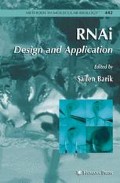Summary
The ability to manipulate RNAi in cultured mammalian cells has provided scientists with a very powerful tool to influence gene expression. Neurons represent a cell type that initially displayed resistance to transduction by siRNAs or shRNA, when attempting to silence expression of endogenous genes. However, the development of lentiviral systems with that goal has facilitated the exogenous manipulation of RNAi in these postmitotic cells. Lentiviral-mediated RNAi experiments in cultured mammalian neurons can be designed to address a wide variety of biological questions or to test potential therapeutic hairpins before moving to treatment trials in vivo. We provide a practical approach to accomplish siRNA-mediated silencing of the disease-linked protein torsinA in primary neuronal cultures through the generation of lentiviral vectors expressing shRNAs.
Access this chapter
Tax calculation will be finalised at checkout
Purchases are for personal use only
References
Ozelius, L. J., Hewett, J. W., Page, C. E., et al. (1997). The early-onset torsion dystonia gene (DYT1) encodes an ATP-binding protein. Nat. Genet. 17, 40–48.
Gonzalez-Alegre, P., and Paulson, H. L. (2004). Aberrant cellular behavior of mutant torsinA implicates nuclear envelope dysfunction in DYT1 dystonia. J. Neurosci. 24, 2593–2601.
Goodchild, R. E., and Dauer, W. T. (2004). Mislocalization to the nuclear envelope: An effect of the dystonia-causing torsinA mutation. Proc. Natl. Acad. Sci. USA 101, 847–852.
Naismith, T. V., Heuser, J. E., Breakefield, X. O., and Hanson, P. I. (2004). TorsinA in the nuclear envelope. Proc. Natl. Acad. Sci. USA 101, 7612–7617.
Goodchild, R. E., Kim, C. E., and Dauer, W. T. (2005). Loss of the dystonia-associated protein torsinA selectively disrupts the neuronal nuclear envelope. Neuron 48, 923–932.
Walker, R. H., and Shashidharan, P. (2003). Developments in the molecular biology of DYT1 dystonia. Mov. Disord. 18, 1102–1107.
Gonzalez-Alegre, P., Miller, V. M., Davidson, B. L., and Paulson, H. L. (2003). Toward therapy for DYT1 dystonia: Allele-specific silencing of mutant torsinA. Ann. Neurol. 53, 781–787.
Gonzalez-Alegre, P., Bode, N., Davidson, B. L., and Paulson, H. L.(2005). Silencing primary dystonia: Lentiviral-mediated RNA interference therapy for DYT1 dystonia. J. Neurosci. 25, 10502–10509.
Meberg, P. J., and Miller, M. W. (2003). Culturing hippocampal and cortical neurons. Meth. Cell Biol. 71, 111–127.
Harper, S. Q., Staber, P. D., Beck, C. R., et al. (2006). Optimization of feline immunodeficiency virus vectors for RNA interference. J. Virol. 80, 9371–9380.
Rubinson, D. A., Dillon, C. P., Kwiatkowski, A. V., et al. (2003).A lentivirus-based system to functionally silence genes in primary mammalian cells, stem cells and transgenic mice by RNA interference. Nat. Genet. 33, 401–406.
Davidson, B. L., and Harper, S. Q. (2005). Viral delivery of recombinant short hairpin RNAs. Meth. Enzymol. 392, 145–173.
Johnston, J. C., Gasmi, M., Lim, L. E., et al. (1999). Minimum requirements for efficient transduction of dividing and nondividing cells by feline immunodeficiency virus vectors. J. Virol. 73, 4991–5000.
Hewett, J., Ziefer, P., Bergeron, D., et al. (2003). TorsinA in PC12 cells: Localization in the endoplasmic reticulum and response to stress. J. Neurosci. Res. 72, 158–168.
Acknowledgments
Research on RNAi was funded by the Dystonia Medical Research Foundation (P. G.-A.) and NIH/NINDS (S. Q. H. and P. G.-A.). We are grateful to all the members of the Davidson, Gonzalez, and Paulson laboratories and the Gene Transfer Vectors Core at The University of Iowa for all the hard work carried out to develop and optimize the protocols described here.
Author information
Authors and Affiliations
Editor information
Editors and Affiliations
Rights and permissions
Copyright information
© 2008 Humana Press, a part of Springer Science+Business Media, LLC
About this protocol
Cite this protocol
Harper, S.Q., Gonzalez-Alegre, P. (2008). Lentivirus-Mediated RNA Interference in Mammalian Neurons. In: Barik, S. (eds) RNAi. Methods in Molecular Biology™, vol 442. Humana Press. https://doi.org/10.1007/978-1-59745-191-8_8
Download citation
DOI: https://doi.org/10.1007/978-1-59745-191-8_8
Publisher Name: Humana Press
Print ISBN: 978-1-58829-874-4
Online ISBN: 978-1-59745-191-8
eBook Packages: Springer Protocols

